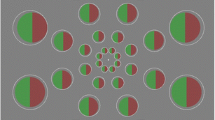Abstract
Three experiments were performed to determine the effect of figure complexity on discrimination performance. In Experiment 1, domestic cats were trained using a successive training method to discriminate vertical mirror image pairs of asymmetric 4-, 8-, and 12-sided figures. In Experiment 2, the same subjects were trained using a concurrent training method to discriminate novel pairs of figures similar to those of Experiment 1. Test results from both experiments showed that (a) visual discrimination performance of the cat was facilitated with test items of greater figure complexity and (b) the concurrent training method was more efficient. In Experiment 3, experimentally naive cats were trained using a concurrent training method to discriminate seven test item pairs. The test items were vertical mirror image pairs of asymmetric 4-, 8-, 12-, 16-, and 22-sided figures as well as horizontal versus vertical stripes and upright versus inverted equilateral triangles. Percentages of correct performance for the figures composed an inverted U function with a peak at the 8-sided figure pair. Furthermore, supportive evidence was found for the common assumption that equilateral triangle and stripe discriminations are relatively easy tasks for the cat.
Similar content being viewed by others
References
ATTNEAVE, F., & ARNOULT, M. D. (1956). The quantitative study of shape and pattern perception. Psychological Bulletin, 53, 452–471.
BROWN, D. R., HITCHCOCK, L., & MICHELS, K. M. (1962). Quantitative studies in form perception: An evaluation of the role of selected stimulus parameters in the visual discrimination performance of human subjects. Perceptual and Motor Skills, 14, 519–529.
CARLSON, K. R. (1973). Visual discrimination learning of random figure problems by rhesus monkeys. Animal Learning and Behavior, 1, 33–37.
CROOK, M. N. (1957). Facsimile-generated analogues for instrumental displays. In J. W. Wulfule & J. H. Taylor (Eds.), Form discrimination as related to military problems. Washington National Research Council, 85–89.
GELLERMAN, L. W. (1933). Chance order of alternating stimuli in visual discrimination experiments. Journal of Genetic Psychology, 42, 26–35.
LAVOND, D. G., & DEWBERRY, R. G. (1980). Visual form perception is a function of the visual cortex: II. The rotated horizontal-vertical and oblique-stripes pattern problem. Physiological Psychology, 8, 1–8.
LAVOND, D. G., HATA, M. G., GRAY, T. S., GECKLER, C. L., MEYER, P. M., & MEYER, D. R. (1978). Visual form perception is a function of the visual cortex. Physiological Psychology, 6, 471–477.
MICHELS, K. M., PITTMAN, G. G., HITCHCOCK, L., & BROWN, D. R. (1962). Visual discrimination: Tree squirrels and quantified stimulus dimensions. Perceptual and Motor Skills, 15, 443–450.
MICHELS, K., & ZUSNE, L. (1965). Metrics of visual form. Psychological Bulletin, 63, 74–86.
NASH, A., & MICHELS, K. (1966). Squirrel monkeys and discrimination learning: Figurai interactions, redundancies, and random shapes. Journal of Experimental Psychology, 72, 132–137.
OWEN, D., & BROWN, D. (1970). Visual and tactual discrimination: Psychophysical comparison within and between modalities. Perception and Psychophysics, 7, 302–306.
RITCHIE, G. D., MEYER, P. M., & MEYER, D. R. (1976). Residual spatial vision of cats with lesions of the visual cortex. Experimental Neurology, 53, 227–253.
SPEAR, P. D. (1979). Behavioral and neurophysiological consequences of visual cortex damage: Mechanisms of recovery. In J. M. Sprague & A. N. Epstein (Eds.), Progress in psychobiology and physiological psychology (pp. 45–90). New York: Academic Press.
SPEAR, P. D., & BRAUN, J. J. (1969). Pattern discrimination following removal of visual neocortex in the cat. Experimental Neurology, 25, 331–348.
Author information
Authors and Affiliations
Rights and permissions
About this article
Cite this article
White, D.A., Ward, J.P. Visual Discrimination in the Cat As a Function of Test Item Complexity and Method of Training. Psychol Rec 38, 285–297 (1988). https://doi.org/10.1007/BF03395024
Published:
Issue Date:
DOI: https://doi.org/10.1007/BF03395024




